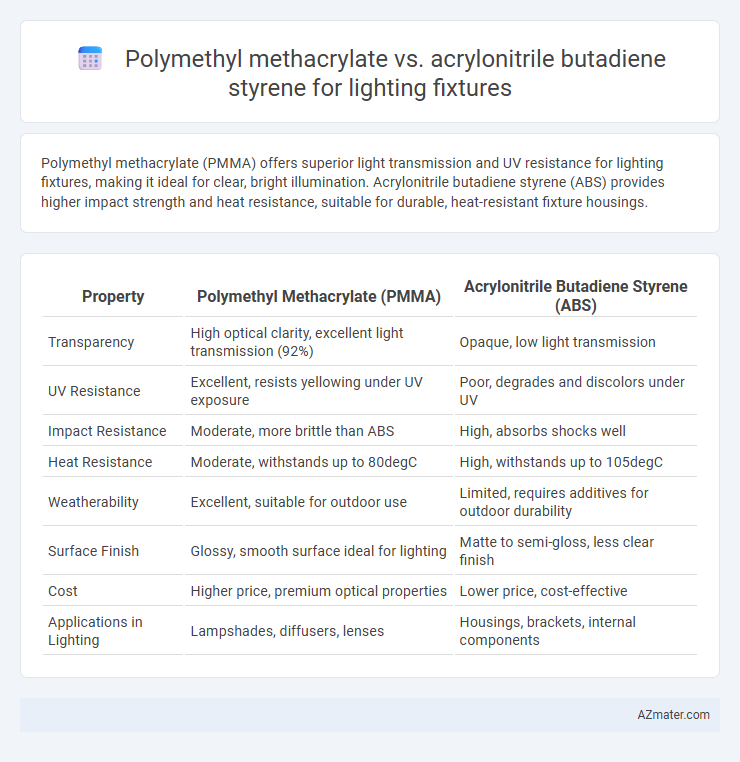Polymethyl methacrylate (PMMA) offers superior light transmission and UV resistance for lighting fixtures, making it ideal for clear, bright illumination. Acrylonitrile butadiene styrene (ABS) provides higher impact strength and heat resistance, suitable for durable, heat-resistant fixture housings.
Table of Comparison
| Property | Polymethyl Methacrylate (PMMA) | Acrylonitrile Butadiene Styrene (ABS) |
|---|---|---|
| Transparency | High optical clarity, excellent light transmission (92%) | Opaque, low light transmission |
| UV Resistance | Excellent, resists yellowing under UV exposure | Poor, degrades and discolors under UV |
| Impact Resistance | Moderate, more brittle than ABS | High, absorbs shocks well |
| Heat Resistance | Moderate, withstands up to 80degC | High, withstands up to 105degC |
| Weatherability | Excellent, suitable for outdoor use | Limited, requires additives for outdoor durability |
| Surface Finish | Glossy, smooth surface ideal for lighting | Matte to semi-gloss, less clear finish |
| Cost | Higher price, premium optical properties | Lower price, cost-effective |
| Applications in Lighting | Lampshades, diffusers, lenses | Housings, brackets, internal components |
Introduction to Polymethyl Methacrylate (PMMA) and Acrylonitrile Butadiene Styrene (ABS)
Polymethyl Methacrylate (PMMA) is a transparent thermoplastic known for its excellent light transmission, high scratch resistance, and UV stability, making it ideal for lighting fixture covers and lenses. Acrylonitrile Butadiene Styrene (ABS) is a robust, impact-resistant thermoplastic with superior mechanical strength and heat resistance, commonly used for lighting fixture housing and structural components. Selecting PMMA or ABS depends on the fixture's requirement for clarity, durability, and thermal stability.
Material Composition and Chemical Properties
Polymethyl methacrylate (PMMA) features a transparent, rigid polymer structure with excellent UV resistance and weatherability, making it ideal for lighting fixtures requiring high clarity and durability. Acrylonitrile butadiene styrene (ABS) is a tough, impact-resistant thermoplastic composed of acrylonitrile, butadiene, and styrene, offering superior mechanical strength but lower UV stability compared to PMMA. The chemical composition of PMMA provides better optical clarity and chemical resistance, while ABS's composition yields enhanced toughness and heat resistance suited for protective lighting components.
Optical Clarity and Light Transmission
Polymethyl methacrylate (PMMA) offers superior optical clarity and light transmission, making it ideal for lighting fixtures requiring high transparency and minimal light diffusion, with light transmittance values typically around 92%. Acrylonitrile butadiene styrene (ABS) has limited optical clarity and lower light transmission, usually below 10%, due to its opaque nature and light-scattering properties. PMMA's excellent UV resistance and scratch resistance further enhance its performance in lighting applications compared to ABS.
Impact Resistance and Durability
Polymethyl methacrylate (PMMA) offers excellent optical clarity but has lower impact resistance compared to Acrylonitrile butadiene styrene (ABS), which provides superior toughness and durability for lighting fixtures. ABS withstands high-impact forces and mechanical stress better, making it ideal for environments requiring robust protection and long-term performance. For lighting applications demanding both durability and moderate transparency, ABS is preferred due to its enhanced impact resistance and resistance to weathering.
Heat Resistance and Thermal Stability
Polymethyl methacrylate (PMMA) offers moderate heat resistance with a glass transition temperature around 105degC, making it suitable for lighting fixtures that require clarity and moderate thermal stability. Acrylonitrile butadiene styrene (ABS) exhibits superior thermal stability and heat resistance, with a heat deflection temperature typically between 90degC and 110degC, but ABS is less transparent compared to PMMA. For lighting fixtures exposed to higher temperatures or requiring impact resistance, ABS is preferred, while PMMA excels in applications demanding optical clarity under moderate heat conditions.
Ease of Fabrication and Forming Capabilities
Polymethyl methacrylate (PMMA) offers superior optical clarity and can be easily thermoformed and machined, making it ideal for intricate lighting fixture designs requiring smooth finishes and precise shapes. Acrylonitrile butadiene styrene (ABS) provides excellent impact resistance and toughness with good moldability, allowing for efficient injection molding but less optical transparency compared to PMMA. PMMA excels in applications demanding seamless light diffusion and detailed forming, whereas ABS is favored for durable, cost-effective fixtures with robust mechanical properties.
Weight and Mechanical Strength Comparison
Polymethyl methacrylate (PMMA) offers a lighter weight compared to Acrylonitrile Butadiene Styrene (ABS), making it ideal for lightweight lighting fixtures where ease of installation and reduced load are critical. ABS exhibits superior mechanical strength and impact resistance, providing enhanced durability and robustness for fixtures subjected to physical stress or frequent handling. The choice between PMMA and ABS hinges on balancing the need for lightweight design against mechanical strength requirements in lighting applications.
Weatherability and UV Stability
Polymethyl methacrylate (PMMA) offers superior weatherability and UV stability compared to Acrylonitrile butadiene styrene (ABS), making it ideal for outdoor lighting fixtures exposed to prolonged sunlight. PMMA resists yellowing and maintains clarity over time, ensuring consistent light transmission and aesthetic appeal in harsh environmental conditions. ABS, while impact-resistant, tends to degrade and discolor under UV exposure, limiting its durability in outdoor lighting applications.
Cost-Effectiveness for Lighting Applications
Polymethyl methacrylate (PMMA) offers superior light transmission and UV resistance, making it cost-effective for high-quality lighting fixtures requiring clarity and durability. Acrylonitrile butadiene styrene (ABS) provides higher impact resistance and lower material cost, suitable for budget-conscious lighting applications with less emphasis on optical performance. Considering lifecycle costs, PMMA's longer service life and reduced maintenance justify the initial investment for premium lighting, while ABS appeals for economical, robust fixtures in less demanding environments.
Best Use Cases: PMMA vs ABS in Lighting Fixtures
Polymethyl methacrylate (PMMA) is ideal for lighting fixtures requiring high optical clarity and excellent light transmission, making it suitable for lenses, diffusers, and decorative covers where transparency and UV resistance are critical. Acrylonitrile butadiene styrene (ABS) is preferred for structural components of lighting fixtures that demand superior impact resistance, toughness, and ease of machining, especially in housings, mounting brackets, and enclosures. Choosing between PMMA and ABS depends on whether optical performance or mechanical durability is prioritized in the lighting fixture application.

Infographic: Polymethyl methacrylate vs Acrylonitrile butadiene styrene for Lighting fixture
 azmater.com
azmater.com